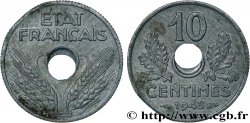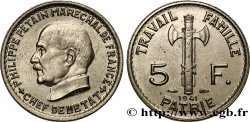v37_1401 - Préparation de la 10 francs Pétain, type Turin, essai en aluminium, tranche striée, léger 1938 Paris VG.cf. 5489 c
MONNAIES 37 (2009)
起拍价 : 180.00 €
估价 : 600.00 €
竞价记录 : 275.00 €
出价数量 : 5
最高出价 : 350.00 €
起拍价 : 180.00 €
估价 : 600.00 €
竞价记录 : 275.00 €
出价数量 : 5
最高出价 : 350.00 €
种类 Préparation de la 10 francs Pétain, type Turin, essai en aluminium, tranche striée, léger
日期: 1938
铸币厂名称/城市 Paris
铸币数量 ---
材质 aluminium
直径 27,95 mm
模子方针 6 h.
重量 2,31 g.
侧面 striée
稀少度 R2
关于品相的说明
Infimes traces de laminage et de manipulation, intéressant phénomène de renflement au centre du revers
出版目录中的项代码 :
家谱
Cet exemplaire provient de la collection Pierre-2
正面
正面的文字 REPUBLIQUE - FRANÇAISE.
正面的说明书 Tête de la République à droite, coiffée d'un bonnet phrygien lauré ; signé P. TURIN sous le buste.
背面
背面的文字 10 / FRANCS / 1938 / LIBERTE / EGALITE / FRATERNITE // ESSAI .
背面的说明书 En sept lignes, entre deux épis de blé verticaux.
评论
Poids léger. Compte tenu du métal, de la date et des autres pré-séries connues, on peut être pratiquement certain que ce type fut utilisé pour mettre au point les 10 francs Pétain, bien qu’il reste possible que ces essais datent de l’immédiate avant-guerre et aient été effectivement destinés à frapper des Turins en aluminium. A contrario, il semble que les réquisitions de métaux n’aient pas été imaginées avant-guerre, donc que l’usage de l’aluminium indique la période de guerre. Si nous avons effectivement affaire à des essais de frappe de 10 francs Pétain, ces essais, du fait de leur métal, sont postérieurs aux essais de frappe au type 1939/1929 puisque ceux-ci n’envisageaient pas encore le rationnement du cuivre et du nickel.
Lightweight. Given the metal, the date and other known pre-series, we can be practically certain that this type was used to develop the 10 franc Pétain, although it remains possible that these tests date from the immediate pre-war period and were actually intended to strike aluminum Turins. On the contrary, it seems that the requisitions of metals were not imagined before the war, so the use of aluminum indicates the war period. If we are indeed dealing with test strikes of 10 franc Pétain, these tests, because of their metal, are later than the test strikes of the 1939/1929 type since these did not yet envisage the rationing of copper and nickel
Lightweight. Given the metal, the date and other known pre-series, we can be practically certain that this type was used to develop the 10 franc Pétain, although it remains possible that these tests date from the immediate pre-war period and were actually intended to strike aluminum Turins. On the contrary, it seems that the requisitions of metals were not imagined before the war, so the use of aluminum indicates the war period. If we are indeed dealing with test strikes of 10 franc Pétain, these tests, because of their metal, are later than the test strikes of the 1939/1929 type since these did not yet envisage the rationing of copper and nickel








 对产品描述纠错
对产品描述纠错 打印
打印 分享我的选择
分享我的选择 提问
提问 Consign / sell
Consign / sell
 产品介绍
产品介绍









